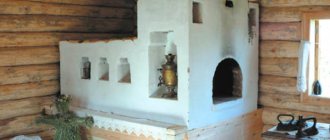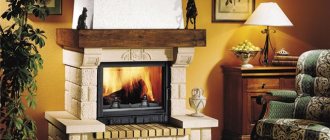Since ancient times, it was believed that the stove in the house was the main property. It doesn’t just heat and makes it possible to cook tasty and healthy food. She is a symbol of comfort, a home that should be preserved and protected. Therefore, skilled stove makers have always been considered a privileged caste. After all, the home nurse had to be built in such a way that it could be quickly and hotly heated, so that in the most severe frost the whole house would be warm and cozy, and the sizzling of the cooking food and the aroma of pies would spread from room to room. But before you start building, you need to calculate the location of the stove in the house. So that not a single molecule of heat is wasted.
What to consider when choosing a location for the stove
Home design
The first and immutable requirement when choosing a furnace location is the complete design of the house. That is, the location of the stove in the house should be planned simultaneously with the walls. In this case, it will not happen that one room will be unbearably hot, and the other will be bitterly cold. And it’s much easier to pour the foundation under it before the floors are laid.
But there are other rules that should be followed.
- Under no circumstances should the foundation for the stove be connected to a common foundation. Over time, the house will definitely shrink and the least that will happen is that the stove will become covered with cracks, from which wisps of smoke will constantly curl, making it impossible and even dangerous to stay in the room. Well, at most it will simply warp and require a lot of repairs.
- The location must be selected in such a way that the chimney is in close proximity to the internal main wall. It will be possible to support the pipe on the ceiling beam.
- Be sure to take into account the layout of the house. Number of rooms and windows. The need to heat the second floor, if there is one. And the material from which the house is built.
- Next, the approximate heat loss of the entire structure is calculated. From here the heat transfer of all surfaces of the stove is calculated.
- The design of the furnace itself must also be thought out in advance.
- Well, one last thing. If the house is too large and one heating device is not enough, you should calculate how many stoves will need to be installed and in what places.
Many years and even centuries of experience show that building too many chimneys means consuming an increased amount of firewood. There is no need to make a separate stove for each room. This is why it is called an ideal location, because with a minimum of space, the largest possible area is heated.
And one more important fact. A stove, no matter what type of fuel it is heated with, is a device around which some amount of garbage, dirt, ash, soot and other dirty substances always accumulate. Therefore, it is better to make the firebox hole in the room that is closest to the front door. Then you won’t have to carry firewood, buckets and bags of ash across the whole house. Believe me, after these voyages the rooms will definitely have to be cleaned.
Heating a one-room house
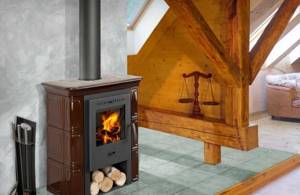
Small stove
There are three ways to place a stove in a house where there is only one room and there is not a single wall, even separating the kitchen or hallway.
- If the room is not very large, the fact that free space comes to the fore. A stove, even the smallest one, if placed in the middle, will steal a lot of it. In this case, the heat output will be maximum, there is nothing to say here, but constantly cruising around it is not entirely convenient. This option is suitable only with a spacious room.
- If you place the stove against the wall, there will be more free space. But, you say, in this case one working surface of the wall will work idle, directly heating the wall near which it is located. This is true, and in this case the wall must be protected from overheating using thermal insulation materials. Or place the stove so that there is a small gap between it and the wall, at least 15 centimeters wide. And the wall will be safe, and the warm air circulating in this opening will also work to heat the entire room.
- In very small houses, a stove of a special design is placed in the corner, observing all safety measures. Usually two work surfaces are enough to heat the entire room.
However, we must not forget that real skilled stove makers can even make a small stove in such a way that it can accommodate a stove, an oven and other auxiliary devices. Well, if used correctly, it will heat no worse than a real Russian village stove.
About the outlet of the chimney and chimney pipes
If possible, it is better to make a brick chimney for steel stoves. In this case, by covering the steel pipe with brick, an additional heating surface for the room is obtained. The brick will heat up from the temperature of the exhaust gases and gradually release heat to the room. This design will protect owners from burns when touching the pipe. The inner surface of the steel pipe is smooth, therefore reducing the risk of rapid deposition of a thick layer of soot and frequent cleaning of the channels.
Near the floor slab, you can switch to sandwich pipes or simple steel pipes. A hole is made in the floor slab and a section of the chimney is inserted into it. Then this place is wrapped with a layer of mineral wool or other heat-insulating material and covered with a layer of decorative finishing.
All parts are fixed to the wall at a certain distance using clamps with self-tapping screws. To exit through the roof, you will need to make a hole in it and install a special coupling or wrap it with a layer of thermal insulation. From the inside, the hole is sealed with polyurethane foam or heat-resistant sealants. On the outside, a layer of sealant and the main roof covering is used.
The chimney pipe is installed above the roof ridge at a distance of 1000 mm and is covered with a protective canopy.
If the chimney exits close to the wall, the upper cut of the pipe should be on the horizontal deviation line from the ridge by 100. Date: September 25, 2021
Heating a multi-room house
One-room houses can now only be found in collective gardens, where the size of the garden is much more important than one’s own amenities. And in winter, the owners rarely come there, and the house usually remains unheated from autumn to spring. By and large, this is not required, so a small stove is enough for them.
It’s another matter when the house has many rooms or even two or even three floors. There is no way to do without a well-thought-out heating system. And if, in order to heat the second and especially the third floor, you have to design and install an entire heating system, for example water or air, then in a one-story house you can get by with one, correctly located stove.
And here you have to dance... not from the stove. And on the number and location of rooms and interior partitions.
As already mentioned, the location of the Russian stove must be calculated at the design stage of the entire structure. And don’t just point your finger at the plan of the future house, but think carefully about where the hallway, kitchen, bedroom, and so on will be. This will determine not only where the stove will stand, but also in which direction it will be turned, which means the stove maker will be able to fold it in the most optimal way, laying the chimney so that it heats the necessary surfaces, and the cleaning holes do not go above the bed .
- Two rooms. To heat them evenly, the stove must be built into the interior partition so that the working surface of the stove is in the first room, and the second in the second. Make the firebox in the room closest to the exit.
- Three rooms. In this case, you will really have to dance from the stove. It should be located approximately in the middle of the entire building, and interior partitions should be attached to it so that the stove is evenly divided between all three rooms. A larger exception can be made in favor of the kitchen.
- Four rooms. And this option is quite possible. The principle is the same as in a three-room house, only the stove will have to be divided into four parts. And this is as easy as shelling pears. The Russian stove is usually four-sided, so there shouldn’t be any big problems.
- Stove with fireplace. This option requires more skill from the stove maker than from the designer. It is he who must fold the stove in such a way that in one room there is a regular firebox and, if necessary, a stove. But into the second fireplace hearth. The difficulty is that the fireplace has an open firebox and a direct chimney is needed to create draft, otherwise the fireplace will smoke into the room.
In even more spacious houses, or in those where there are only two, but huge rooms, a single stove may not cope. And then you will have to install an assistant for her, or make a heating system.
Iron stove in the house
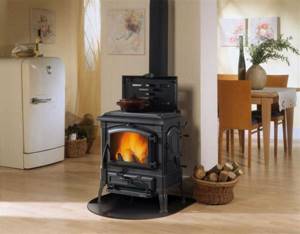
Iron stove
Sweet, kind, blazing hot, red-hot “potbelly stove”. True, modern stylish versions of iron wood-burning stoves no longer fit this name, but its functions have not changed.
Installing an iron stove in a house is much easier than building a brick one, however, its safety requirements are somewhat higher.
- Fire safety. The temperature of the walls of an iron wood-burning stove is several times higher than that of a brick stove. Therefore, care must be taken when handling it.
- It is also necessary to protect the floor and walls near which it is installed from overheating.
- The installation location is calculated taking into account the location of windows and doors in the room. But no closer than 50 cm from the wall, even if it is impregnated with a fire retardant substance and finished with non-flammable materials.
- It is also necessary to equip a place around the stove where firewood, tools and other elements necessary for proper operation will be stored.
Of course, such a stove alone cannot heat a multi-room house, which is why it is used in most cases in small or temporary houses. Although, if you install it in a utility room and connect it to a water heating system, then even a two-story house will be warm.
Stages of work
| Call or request. You leave a request on the website or call by phone. | Departure of an expert engineer to assess the facility | Drawing up an estimate based on measurement results | We sign a contract for installation work | Ready! Reception of work, you inspect and accept the work |
If you do not have enough time to select pipes and components, our specialist will select materials and give the necessary recommendations and advice on use, as well as provide an approximate cost of the work.
Fire protection
Another most important question that you should think carefully about at the same time as how to determine the correct location of the stove in a wooden house is how to protect it from fire. Proper and careful handling of heating appliances is not always enough.
Fire is an unpredictable and difficult to control element. And if by some chance he broke free, then it is very difficult to stop him. That is why you should initially consider security measures.
- Firstly, this issue should also be addressed at the design stage. Different types of wood used in the construction of residential buildings have different flammability classes. Naturally, you need to choose the safest one.
- In addition, walls, especially in the immediate vicinity of the stove, can be treated with special substances. So-called fire retardants are not expensive, but they can bring a lot of benefits. It must be said right away that they will not make the wall completely impervious to fire. But they will significantly reduce the flammability threshold and slow down the combustion process itself.
- It would be a good idea to cover the walls and floor near the stove with special fire-resistant finishing materials. Asbestos, cement or gypsum plaster, facing brick are great for this purpose, turning the stove area not only into a safe, but also a beautiful space.
- But the use of vinyl and polymer finishing materials in these places is not only not recommended, but is also considered dangerous. They have the very unpleasant property of releasing very toxic chemicals when burned, which leads to severe poisoning and even death.
Insulation of walls and floors around the fireplace
To insulate the walls, multilayer insulating materials are used (basalt wool with a reflective screen, sheets of non-flammable synthetic material), brick.
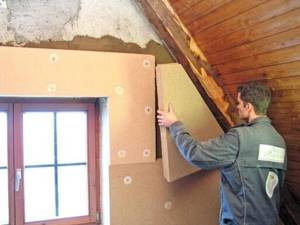
Properly performed thermal insulation is the key to safety and is carried out using materials such as mineral wool, polystyrene foam, tape tow and others
Before you begin installing the slabs, you need to mark the area around the fireplace within a radius of 75 cm. This is where the multilayer insulation sheets will be attached to a metal profile.
Fire-resistant plasterboard sheets are mounted on top of this layer. The cracks can be sealed with foil. Then reinforcing mesh, putty and painting.
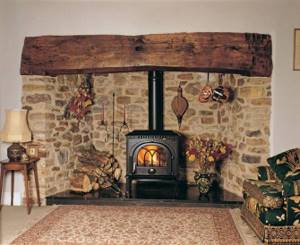
Or the walls near the fireplace can be lined with brick, ceramic tiles, stone, if such a solution fits organically into the design of the room
The flooring around the fireplace must be treated with a facing material that can withstand high temperatures.
The space around the fireplace at a distance of 1.5 meters should be covered with cladding. What are marble, granite and ceramic tiles used for?
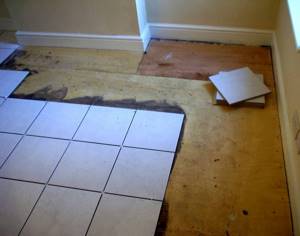
Lining the floor near the fireplace protects it from high temperatures, thereby preventing various types of damage
During operation, the fireplace requires constant care, since where there is fire, there is always a risk. It is important to periodically clean the fireplace chimney from accumulation of soot and deposits.
In addition, you need to take care of the appearance of the fireplace and wipe dust from its surface.
Russian stove with stove bench

Russian stove with stove bench
For a wooden multi-room house, this is perhaps the best option, although it is becoming less and less common. Firstly, because there are fewer and fewer skilled stove makers who can correctly build such a stove. And secondly, it simply went out of fashion, but in vain.
The design features of a real Russian stove are not only that it is capable of heating a fairly large multi-room house. With the correct location and high-quality performance, such a stove is much more economical. The internal chimneys are designed in such a way that they heat not only the main body of the stove, but also the stove bench, which can be taken out into any room if desired, and the dryer. It takes quite a long time to cool down, and a very small amount of firewood is required for daily heating.
Well, there is no escape from such an element as a kitchen stove, on which you must be able to cook, but if you master this ancient art, then the whole house will be filled with amazing aromas. It’s not without reason that they say that pies, porridge and borscht are the most delicious from the Russian oven.
Let's sum it up
So, there are not so many options for the correct location of a brick or iron wood-burning stove. They depend on the layout of the house and the design of the stove itself. It is necessary to choose a location at the design stage and it is better to have a real specialist do this, who can calculate both the heat loss of the house and the heat transfer of the furnace located in one place or another.
But no matter what option you choose, wall-mounted, corner, in an interior partition, with a hob or fireplace, fire safety measures should not be neglected under any circumstances.
And then your home will be warm, cozy, fun and festive, no matter what bad weather is raging outside the window.
How a FORUMHOUSE user installed a cast iron fireplace stove
Many of us dream of sitting with the whole family by the hot fireplace in a country house on cold winter evenings. Steam is rising from cups of tea, a dog is dozing on a wicker rug, and snow is quietly falling outside the window. Cozy picture! But after the choice falls on wood as the main material for building a house, the question arises: how to make a stove so that it is as safe as possible.
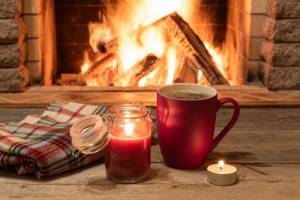
Alas, the experience of many users on various sites in the Internet space shows that often even the experts do not always do their job as needed.
Content
Today we want to talk about how FORUMHOUSE portal user ansushkov made a cast iron fireplace stove in a house built from timber.
